英语国家概况 英国教育
《英语国家概况》英国教育历史发展课件

二战后英国教育发展与改革
1944年
《1944年 教育改革法》 与学制构建
1963年
《罗宾斯报 告》与高等教 育大发展
1988年
《1988年 教育改革法》 与国家统一课 程
英国现行教育制度
英国教育行政制度
中央教育行政
议会
内阁与枢密院
教育与技能部 (Department of Education and Skills)
至二战结束前,英国教育双轨制非常明显,公立学 校和私立学校并存,各成体系,互不相同。
二战前英国教育演进
13C’以前
以宗教教义 为核心的宗教 教育时期
13C’~ 16C’
贵族教育的 形成与发展
17C’~20C’ 初
平民教育 的产生与发展, 双轨制的确立
第二次世界大战后的英国教育发展与改革
《1944年教育法》 主要内容:
在权力分配方面,教育和科学部只是进行宏观调控, 地方一级才对学校具有经营与管理的实权,他们不是 上下级的从属关系,而是一种“伙伴”关系。
英国教育行政制度概述
地方教育行政 英国现行地方政府体制,以都市郡的区、非都市郡、
内伦敦和外伦敦的市为地方教育行政单位。地方教育 当局从总体上负责协调本地区教育的管理,促进教育 质量的提高,其主要职责是:为本地区的学校制订目 标,对学校系统进行监督、评价和指导;维持部分教 育经费的分配与控制权;管理和规划本地区的继续教 育。地方教育当局包括教育委员会和教育局。
《 1988年教育改革法》与推行国家统一课程
《1988年教育改革法》最引人注目的改革措施就是推行国 家统一课程。该法由此被认为是继《1944年教育法》后英国 最重要的一部教育法。
《1988年教育改革法》规定:在义务教育期间,学生必须 学习国家统一课程,包括10门基础学科,数学、英语、科学、 历史、地理、技术学、音乐、艺术、体育和现代外语,其中数 学、科学、英语为核心课程;为每门国家课程制定统一的成绩 目标和教学大纲,并在7、11、14和16岁时对学生进行全国 性评估,包括国家规定的考试。在高等教育方面,对负责大学 和高等教育系统的两大中介拨款机构进行了改革,目的在于加 强政府对大学的控制,密切高等教育与社会和工商界的联系。
英语国家概况英美对比
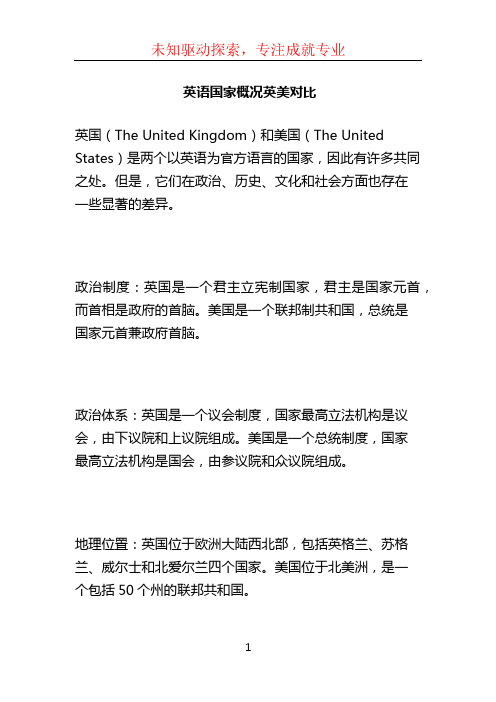
英语国家概况英美对比英国(The United Kingdom)和美国(The United States)是两个以英语为官方语言的国家,因此有许多共同之处。
但是,它们在政治、历史、文化和社会方面也存在一些显著的差异。
政治制度:英国是一个君主立宪制国家,君主是国家元首,而首相是政府的首脑。
美国是一个联邦制共和国,总统是国家元首兼政府首脑。
政治体系:英国是一个议会制度,国家最高立法机构是议会,由下议院和上议院组成。
美国是一个总统制度,国家最高立法机构是国会,由参议院和众议院组成。
地理位置:英国位于欧洲大陆西北部,包括英格兰、苏格兰、威尔士和北爱尔兰四个国家。
美国位于北美洲,是一个包括50个州的联邦共和国。
历史:英国是一个历史悠久的国家,曾经是大英帝国的中心。
美国是一个相对较年轻的国家,于18世纪末脱离了英国的统治,并在19世纪发展成为一个强大的国家。
文化:英国是文化的发源地之一,拥有众多的文学、戏剧和音乐作品。
美国文化则是一个融合了来自世界各地的移民文化的独特混合体,具有多样性和包容性。
语言:英国英语和美国英语有一些差异,包括发音、词汇和拼写等方面。
英国英语通常被认为更加保守和正式,而美国英语则更加开放和非正式。
经济:英国是世界上最大的金融中心之一,拥有发达的服务业和制造业。
美国是世界上最大的经济体,具有多样化和创新的经济结构。
教育:英国拥有世界上一些最古老和著名的大学,如牛津大学和剑桥大学。
美国也拥有一些世界上顶尖的大学和研究机构,如哈佛大学和斯坦福大学。
总体而言,英国和美国都是世界上具有重要影响力的国家,它们在许多方面都有独特之处,同时也有一些共同的价值观和文化传统。
《英语国家概况》Unit 9 British Education课件
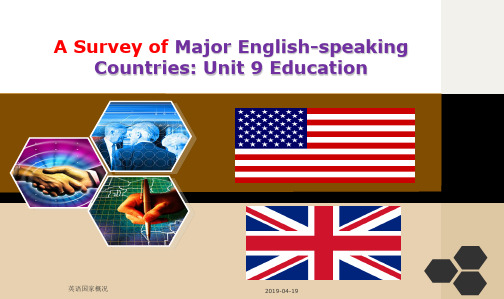
Case Study
• Compared with that in Chinese counterparts, the curriculum in the UK primary or secondary schools is much simpler. (esp. mathematics & reading)
• Prep Schools (预备学校) (from 7/8 to 13) (separate; fees; entrance exam )
• State Schools (93%) 1. Comprehensive Schools ( 综 合 中 学 ) (84%) (No
entrance exam, general education)
Tertiary education
• 延续教育(Further Education)是继小学(Primary)中学 (Secondary)教育之后的“第三级教育”(Tertiary)。为 进入高等教育或者就业打下基础。也是中国的高中学生 留学英国的关键阶段。一般来说接受延续教育的学生介 于16和18岁之间。
• Other pupils who decide not to go to university may choose to take vocational training and get the GNVQ (General National Vocational Qualification 国家专业资 格证书, 5 levels).
• At 18, they take GCE A-level examinations (Advanced General Certificate of Education 高级水平普通教育证书 =大学入学考试), usually in not more than 3 subjects. It’s necessary to have A-levels in order to go to a university or other institutions of higher education.
英语国家概况复习资料

英语国家概况复习资料英语国家概况复习资料英语国家概况是学习英语的重要一环,了解英语国家的历史、文化、地理等方面,有助于更好地理解和运用英语。
在这篇文章中,我们将回顾一些关于英语国家的基本知识,帮助大家复习和加深对这些国家的了解。
一、英国(United Kingdom)英国是英语的发源地,也是英语国家中最重要的一个。
它由四个国家组成:英格兰、苏格兰、威尔士和北爱尔兰。
英国是一个具有悠久历史和丰富文化的国家,拥有众多的文学、音乐和戏剧作品。
莎士比亚、狄更斯、毛姆等伟大的作家都出自英国。
此外,英国还有许多著名大学,如剑桥大学和牛津大学。
二、美国(United States)美国是世界上最大的英语国家之一,也是世界上最强大的国家之一。
它拥有丰富的资源和多元化的文化。
美国是一个移民国家,各种不同的文化和宗教在这里融合。
美国有众多著名的城市,如纽约、洛杉矶和芝加哥,每个城市都有其独特的魅力和特色。
此外,美国还是全球科技和创新的领导者,许多世界知名的科技公司都来自美国。
三、加拿大(Canada)加拿大是北美洲的一个国家,是英语和法语并存的国家。
加拿大是一个拥有广阔土地和丰富资源的国家,同时也是一个多元文化的国家。
加拿大的自然风光非常壮观,有着世界上最美丽的国家公园和湖泊。
此外,加拿大在教育和医疗领域也非常发达,拥有世界一流的大学和医疗系统。
四、澳大利亚(Australia)澳大利亚是一个位于南半球的国家,也是一个英语国家。
澳大利亚拥有宽广的土地和独特的动植物资源,是世界上最大的岛屿国家。
澳大利亚的自然环境非常独特,有着世界上最壮观的珊瑚礁和大堡礁。
此外,澳大利亚还以其高质量的教育和研究机构而闻名,吸引着来自世界各地的留学生。
五、新西兰(New Zealand)新西兰是一个位于南太平洋的岛国,也是一个英语国家。
新西兰的自然环境非常优美,有着壮丽的山脉、湖泊和海岸线。
新西兰是一个农业和旅游业发达的国家,其乳制品和葡萄酒在世界上享有盛誉。
英语国家概况 英国chapter7v2

access n. 途径 have access to sth. ad hoc a. 特别的,专门的 on an ad hoc basis 临时权宜地 compulsory adj. 义务的必修的 compulsory education corporal/physical punishment 体罚 elite n. 社会精英 civil servant curriculum n. 课程 plural form? Curricular? evacuate vt. 腾空;腾出 evacuation executive n. 行政人员 CEO? literacy n. 识字;有学问 literate adj. n. 有学问的,学者 illiteracy illiterate truancy n. 逃学;旷课 truant adj. n. truant from school proficient adj. 熟练的;精通的 proficiency residential/boarding school 寄宿学校
The
history of British education system The present education system Higher education
Grammar
school Comprehensive school Vocational school Public school Oxbridge 11-plus examination11+考试 GCSE (General Certificate of Secondary Education)中学毕业证书 General Certificate of EducationAdvanced: A Level 高级水平测试结业证书
英语国家概况(伦敦)
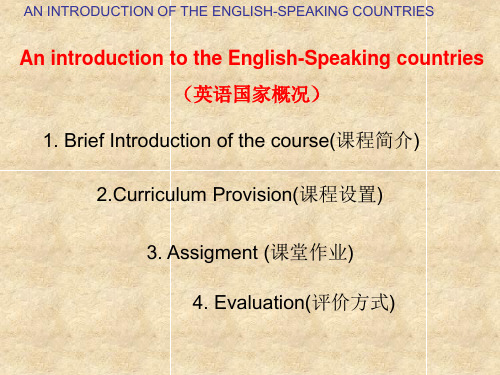
AN INTRODUCTION OF THE ENGLISH-SPEAKING COUNTRIES
AN INTRODUCTION OF THE ENGLISH-SPEAKING COUNTRIES
AN INTRODUCTION OF THE ENGLISH-SPEAKING COUNTRIES
AN INTRODUCTION OF THE ENGLISH-SPEAKING COUNTRIES
AN INTRODUCTION OF THE ENGLISH-SPEAKING COUNTRIES
The United Kingdom (Uk)
AN INTRODUCTION OF THE ENGLISH-SPEAKING COUNTRIES
威斯敏斯特宫
AN INTRODUCTION OF THE ENGLISH-SPEAKING COUNTRIES
威斯敏斯特宫
AN INTRODUCTION OF THE ENGLISH-SPEAKING COUNTRIES
伦敦塔桥
AN INTRODUCTION OF THE ENGLISH-SPEAKING COUNTRIES
North Ireland (北爱尔兰)
AN INTRODUCTION OF THE ENGLISH-SPEAKING COUNTRIES
长宽比: 1:2 The Union Flag
米字旗是大不列颠及北 爱尔兰联合王国的国旗。 它是由英格兰的圣乔治 十字旗(白地红色正十 字)和苏格兰的圣安德 鲁十字旗(蓝地白色斜 十字)加上爱尔兰的圣 帕特里克十字旗(白地 红色斜十字)合并而成。
伦敦眼
英语国家概况(英国部分)
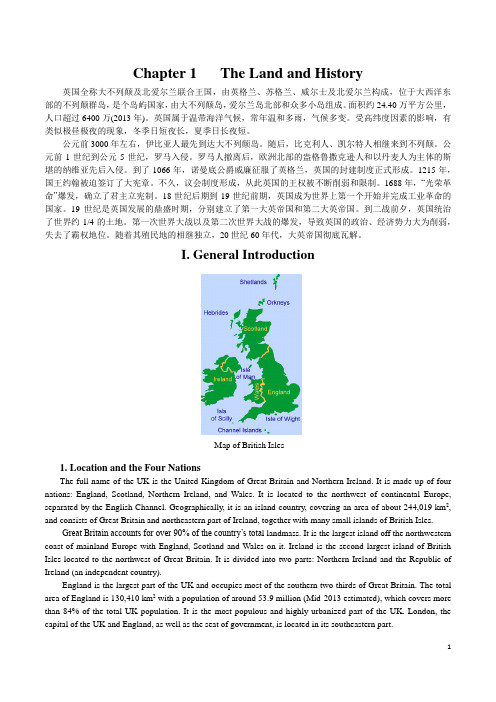
Chapter 1 The Land and History英国全称大不列颠及北爱尔兰联合王国,由英格兰、苏格兰、威尔士及北爱尔兰构成,位于大西洋东部的不列颠群岛,是个岛屿国家,由大不列颠岛,爱尔兰岛北部和众多小岛组成。
面积约24.40万平方公里,人口超过6400万(2013年)。
英国属于温带海洋气候,常年温和多雨,气候多变。
受高纬度因素的影响,有类似极昼极夜的现象,冬季日短夜长,夏季日长夜短。
公元前3000年左右,伊比亚人最先到达大不列颠岛。
随后,比克利人、凯尔特人相继来到不列颠。
公元前1世纪到公元5世纪,罗马入侵。
罗马人撤离后,欧洲北部的盎格鲁撒克逊人和以丹麦人为主体的斯堪的纳维亚先后入侵。
到了1066年,诺曼底公爵威廉征服了英格兰,英国的封建制度正式形成。
1215年,国王约翰被迫签订了大宪章。
不久,议会制度形成,从此英国的王权被不断削弱和限制。
1688年,“光荣革命”爆发,确立了君主立宪制。
18世纪后期到19世纪前期,英国成为世界上第一个开始并完成工业革命的国家。
19世纪是英国发展的鼎盛时期,分别建立了第一大英帝国和第二大英帝国。
到二战前夕,英国统治了世界约1/4的土地。
第一次世界大战以及第二次世界大战的爆发,导致英国的政治、经济势力大为削弱,失去了霸权地位。
随着其殖民地的相继独立,20世纪60年代,大英帝国彻底瓦解。
I. General IntroductionMap of British Isles1. Location and the Four NationsThe full name of the UK is the United Kingdom of Great Britain and Northern Ireland. It is made up of four nations: England, Scotland, Northern Ireland, and Wales. It is located to the northwest of continental Europe, separated by the English Channel. Geographically, it is an island country, covering an area of about 244,019 km2, and consists of Great Britain and northeastern part of Ireland, together with many small islands of British Isles.Great Britain accounts for over 90% of the country’s tota l landmass. It is the largest island off the northwestern coast of mainland Europe with England, Scotland and Wales on it. Ireland is the second largest island of British Isles located to the northwest of Great Britain. It is divided into two parts: Northern Ireland and the Republic of Ireland (an independent country).England is the largest part of the UK and occupies most of the southern two thirds of Great Britain. The total area of England is 130,410 km2 with a population of around 53.9 million (Mid-2013 estimated), which covers more than 84% of the total UK population. It is the most populous and highly urbanized part of the UK. London, the capital of the UK and England, as well as the seat of government, is located in its southeastern part.Scotland is the second largest and most mountainous part of the UK in the north of Great Britain. Compared with that of England, the population density is quite low. There are only 5.3 million people with an area of 78,789 km2. Edinburgh, its largest city, is the capital of Scotland. Scotland is famous for its beautiful natural scenery, such as Scottish Highlands1and Loch Ness2, as well as many historical places, like the Edinburgh Castles.Wales is on the western side of central southern Great Britain. The total area of Wales is 20,779 km2, which accounts for 1/4 parts of the UK. It is also a mountainous part of Great Britain, particularly in the north and central regions. The southeast region is the most built up region of Wales, and the majority of its population live there and a large proportion of its industry is based there. Its capital city, Cardiff, is also in this region.Northern Ireland lies in the northeast of the island of Ireland, covering14,139 km2, which constitutes 1/6 of the island. It is the smallest part among the four nations of the UK, as well as the second sparsely populated part after Scotland. The capital is Belfast, the largest city in Northern Ireland both in population and in area. It is the center for government, economic, arts, higher education, business, law of Northern Ireland. Additionally, it is the birthplace of Titanic, and voted one of the world’s top destinations.2. ClimateThe overall climate in the UK is temperate maritime, which means that it is mild with temperatures neither much lower than 0℃in winter nor much higher 32℃in summer. Generally, the UK has warm summers and cool winters, with July and August as the warmest month, and January and February as the coldest. However, due to the influence of Gulf Stream3, the summers are cooler than those in continent while the winters are milder. Normally, the temperature in summer is around 20℃,with the high rarely going above 30℃. The average temperature in winter is around 0℃and seldom go below -10℃even in the most northern part of the country.Meanwhile, since Britain is an island country and surrounded by the sea, the climate is considerably changeable compared with other countries. Since the variable climate changing day to day, it is hard for people to predict what the weather will be like the next day. Additionally, the unique geographical position is also the reason for the dampness of the climate. The rainfall is fairly distributed throughout the year. Although it does not rain every day, it is always advisable for people to bring an umbrella or waterproof clothing every day.II. History1. The Founding of the NationThe recorded history of the UK begins with the Roman invasion in 55BC. In 55 and 54BC, Britain was twice invaded by Julius Caesar and his Roman troops. However, it was not until 43AD that the Roman led by Claudius I finally successfully invaded and Britain became part of the Roman Empire. The native Celtic were driven to the mountain regions of Scotland and Wales, which remained unconquered by the Romans.The Romans have great impact on many aspects of the British culture. The Roman civilization was introduced to the Britain during this period. For example, Roman style baths and temples were built, cities like London and towns were constructed, and the system of government was also introduced. With the decline of the Roman Empire, when the Germanic troops attacked Rome in 410 A.D., the Romans had to withdraw in order to protect their own nation, which led to the end of Roman occupation.After the leave of the Romans, three groups of Germanic tribes called the Jutes, the Angles and the Saxons came to Britain from the European continent in the mid-4th century. They conquered different regions of Britain:1Scottish Highlands:苏格兰高地,是对苏格兰高地边界断层以西和以北的山地的称,被认为是欧洲风景最优美的地区。
英语国家概况(英国部分)
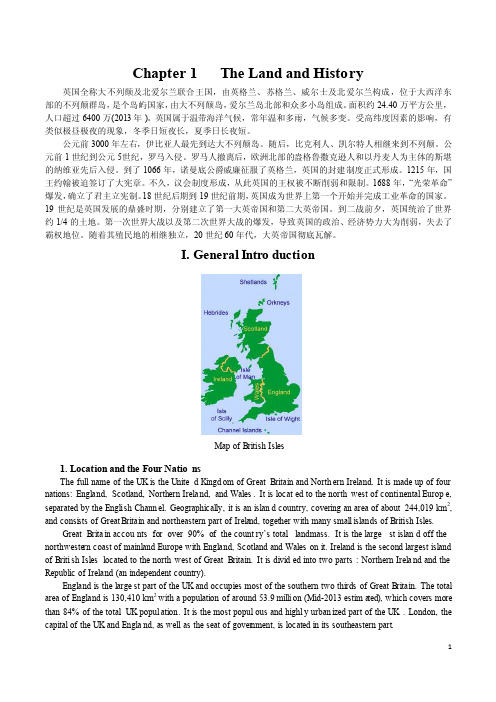
Chapt e r 1 The Land and Histo r y英国全称大不列颠及北爱尔兰联合王国,由英格兰、苏格兰、威尔士及北爱尔兰构成,位于大西洋东部的不列颠群岛,是个岛屿国家,由大不列颠岛,爱尔兰岛北部和众多小岛组成。
面积约24.40万平方公里,人口超过6400万(2013年)。
英国属于温带海洋气候,常年温和多雨,气候多变。
受高纬度因素的影响,有类似极昼极夜的现象,冬季日短夜长,夏季日长夜短。
公元前3000年左右,伊比亚人最先到达大不列颠岛。
随后,比克利人、凯尔特人相继来到不列颠。
公元前1世纪到公元5世纪,罗马入侵。
罗马人撤离后,欧洲北部的盎格鲁撒克逊人和以丹麦人为主体的斯堪的纳维亚先后入侵。
到了1066年,诺曼底公爵威廉征服了英格兰,英国的封建制度正式形成。
1215年,国王约翰被迫签订了大宪章。
不久,议会制度形成,从此英国的王权被不断削弱和限制。
1688年,―光荣革命‖爆发,确立了君主立宪制。
18世纪后期到19世纪前期,英国成为世界上第一个开始并完成工业革命的国家。
19世纪是英国发展的鼎盛时期,分别建立了第一大英帝国和第二大英帝国。
到二战前夕,英国统治了世界约1/4的土地。
第一次世界大战以及第二次世界大战的爆发,导致英国的政治、经济势力大为削弱,失去了霸权地位。
随着其殖民地的相继独立,20世纪60年代,大英帝国彻底瓦解。
I. Gener a l Intro d ucti o n1. Locat i on and the Four Natio n s The full name of the UK is the Unite d Kingd o m of Great Brita i n and North e rn Irela n d. It is made up of four natio n s: Engla n d, Scotl a nd, North e rn Irela n d, and Wales . It is locat e d to the north w est of conti n enta l Europ e , separ a ted by the Engli s h Chann e l. Geogr a phic a lly, it is an islan d count r y, cover i ng an area of about 244,019 km 2, and consi s ts of Great Brita i n and north e aste r n part of Irela n d, toget h er with many small islan d s of Briti s h Isles . Great Brita i n accou n ts for over 90% of the count r y’stotal landm a ss. It is the large s t islan d off the north w este r n coast of mainl a nd Europ e with Engla n d, Scotl a nd and Wales on it. Irela n d is the secon d large s t islan d of Briti s h Isles locat e d to the north w est of Great Brita i n. It is divid e d into two parts : North e rn Irela n d and the Repub l ic of Irela n d (an indep e nden t count r y).Engla n d is the large s t part of the UK and occup i es most of the south e rn two third s of Great Brita i n. The total area of Engla n d is 130,410 km 2 with a popul a tion of aroun d 53.9 milli o n (Mid-2013 estim a ted), which cover s morethan 84% of the total UK popul a tion . It is the most popul o us and highl y urban i zed part of the UK . Londo n , the capit a l of the UK and Engla n d, as well as the seat of gover n ment , is locat e d in its south e aste rn part.Map of Briti s h Isles Scotla nd is the second larges t and most mounta inous part of the UK in the northof GreatBritai n. Compar ed with that of Englan d, the popula tiondensit y is quitelow. Thereare only 5.3 millio n people with an area of 78,789 km2. Edinbu rgh, its larges t city, is the capita l of Scotla nd. Scotla nd is famous for its beauti ful natura l scener y, such as Scotti s h Highla nds1and Loch Ness2, as well as many histor icalplaces, like the Edinbu rgh Castle s.Walesis on the wester n side of centra l southe rn GreatBritai n. The totalarea of Walesis 20,779 km2, whichaccoun ts for 1/4 partsof the UK. It is also a mounta inous part of GreatBritai n, partic ularl y in the northand centra l region s. The southe ast region is the most builtup region of Wales, and the majori ty of its popula tionlive thereand a largepropor tionof its indust ry is basedthere. Its capita l city, Cardif f, is also in this region.Northe rn Irelan d lies in the northe ast of the island of Irelan d, coveri ng14,139 km2, whichconsti tutes 1/6 of the island. It is the smalle st part amongthe four nation s of the UK, as well as the second sparse ly popula ted part afterScotla nd. The capita l is Belfas t, the larges t city in Northe rn Irelan d both in popula tionand in area. It is the center for govern ment,econom ic, arts, higher educat ion, busine ss, law of Northe rn Irelan d. Additi onall y, it is the birthp laceof Titani c, and votedone of the world’stopdestin ation s.2. Climat eThe overal l climat e in the UK is temper ate mariti me, whichmeansthat it is mild with temper ature s neithe r much lowerthan 0℃ in winter nor much higher 32℃ in summer. Genera lly, the UK has warm summer s and cool winter s, with July and August as the warmes t month, and Januar y and Februa ry as the coldes t. Howeve r, due to the influe nce of Gulf Stream3, the summer s are cooler than thosein contin ent whilethe winter s are milder. Normal ly, the temper ature in summer is around20℃,with the high rarely goingabove30℃. The averag e temper ature in winter is around 0℃ and seldom go below-10℃ even in the most northe rn part of the countr y.Meanwh ile, sinceBritai n is an island countr y and surrou ndedby the sea, the climat e is consid erabl y change ablecompar ed with othercountr ies. Sincethe variab le climat e changi ng day to day, it is hard for people to predic t what the weathe r will be like the next day. Additi onall y, the unique geogra phica l positi on is also the reason for the dampne ss of the climat e. The rainfa ll is fairly distri buted throug houtthe year. Althou gh it does not rain everyday, it is always advisa ble for people to bringan umbrel la or waterp roofclothi ng everyday.II. Histor y1. The Foundi ng of the NationThe record ed histor y of the UK begins with the Romaninvasi on in 55BC. In 55 and 54BC, Britai n was twiceinvade d by Julius Caesar and his Romantroops. Howeve r, it was not until43AD that the Romanled by Claudi us I finall y succes sfull y invade d and Britai n became part of the RomanEmpire. The native Celtic were driven to the mounta in region s of Scotla nd and Wales, whichremain ed unconq uered by the Romans.The Romans have greatimpact on many aspect s of the Britis h cultur e. The Romancivili zatio n was introd ucedto the Britai n during this period. For exampl e, Romanstylebathsand temple s were built, cities like London and townswere constr ucted, and the system of govern mentwas also introd uced. With the declin e of the RomanEmpire, when the German ic troops attack ed Rome in 410 A.D., the Romans had to withdr aw in orderto protec t theirown nation, whichled to the end of Romanoccupa tion.Afterthe leaveof the Romans, threegroups of German ic tribes called the Jutes, the Angles and the Saxons came to Britai n from the Europe an contin ent in the mid-4th centur y. They conque red differ ent region s of Britai n:1Scotti sh Highla nds:苏格兰高地,是对苏格兰高地边界断层以西和以北的山地的称,被认为是欧洲风景最优美的地区。
英语国家概况英国的教育体制
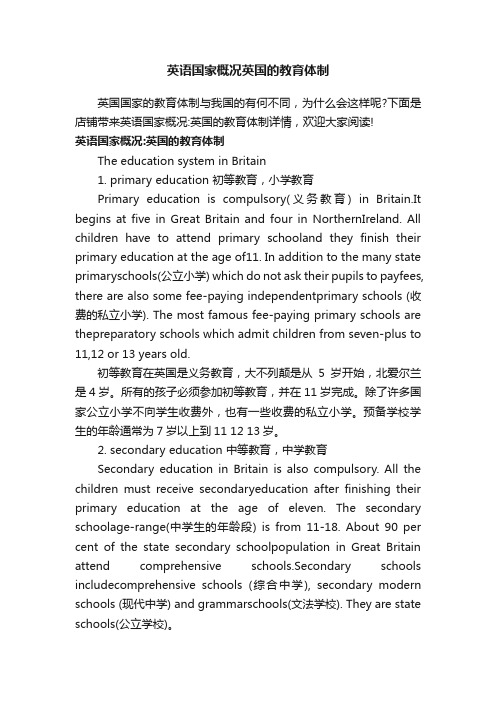
英语国家概况英国的教育体制英国国家的教育体制与我国的有何不同,为什么会这样呢?下面是店铺带来英语国家概况:英国的教育体制详情,欢迎大家阅读!英语国家概况:英国的教育体制The education system in Britain1. primary education 初等教育,小学教育Primary education is compulsory(义务教育) in Britain.It begins at five in Great Britain and four in NorthernIreland. All children have to attend primary schooland they finish their primary education at the age of11. In addition to the many state primaryschools(公立小学) which do not ask their pupils to payfees, there are also some fee-paying independentprimary schools (收费的私立小学). The most famous fee-paying primary schools are thepreparatory schools which admit children from seven-plus to 11,12 or 13 years old.初等教育在英国是义务教育,大不列颠是从5岁开始,北爱尔兰是4岁。
所有的孩子必须参加初等教育,并在11岁完成。
除了许多国家公立小学不向学生收费外,也有一些收费的私立小学。
预备学校学生的年龄通常为7岁以上到11 12 13岁。
2. secondary education 中等教育,中学教育Secondary education in Britain is also compulsory. All the children must receive secondaryeducation after finishing their primary education at the age of eleven. The secondary schoolage-range(中学生的年龄段) is from 11-18. About 90 per cent of the state secondary schoolpopulation in Great Britain attend comprehensive schools.Secondary schools includecomprehensive schools (综合中学), secondary modern schools (现代中学) and grammarschools(文法学校). They are state schools(公立学校)。
英语国家概况期末考试英国教育体制作文
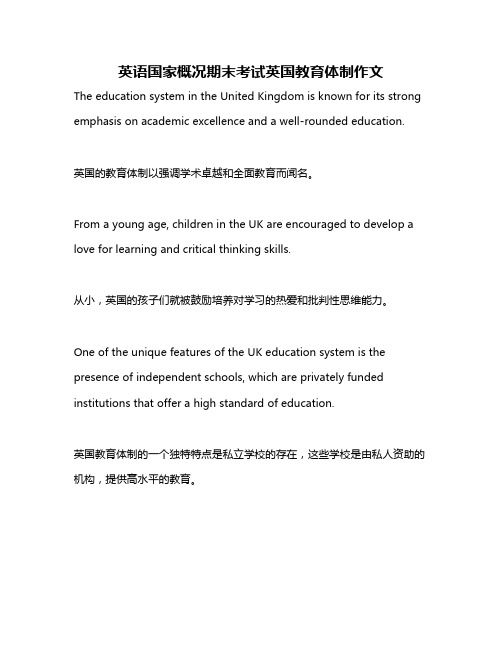
英语国家概况期末考试英国教育体制作文The education system in the United Kingdom is known for its strong emphasis on academic excellence and a well-rounded education.英国的教育体制以强调学术卓越和全面教育而闻名。
From a young age, children in the UK are encouraged to develop a love for learning and critical thinking skills.从小,英国的孩子们就被鼓励培养对学习的热爱和批判性思维能力。
One of the unique features of the UK education system is the presence of independent schools, which are privately funded institutions that offer a high standard of education.英国教育体制的一个独特特点是私立学校的存在,这些学校是由私人资助的机构,提供高水平的教育。
These schools often have smaller class sizes, more resources, and a wider range of extracurricular activities compared to state-funded schools.与公立学校相比,这些学校通常拥有较小的班级规模、更多的资源和更广泛的课外活动。
However, access to independent schools is often limited to those who can afford the high tuition fees, leading to criticisms of elitism and inequality within the education system.然而,私立学校的学费通常较高,只有富有的家庭才能负担得起,这导致对教育体制内精英主义和不平等的批评。
英语国家概况英国宗教
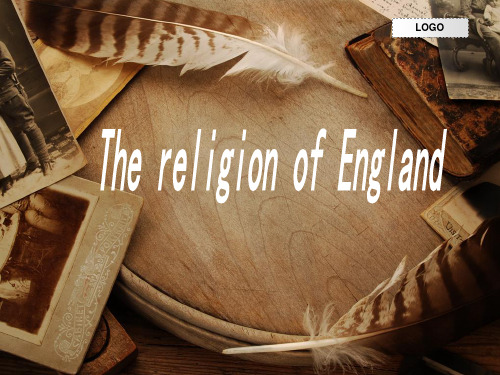
LOGO
(3)罗马天主教会
非国教教会
英格兰和威尔士的罗马天主教会的正式组织在宗教改革后 一度消亡,但于1850年恢复。
大不列颠现在有七个由大主教领导的罗马天主教省,以及 由主教领导的30个主教区(英格兰和威尔士有22个教区,苏 格兰有8个,各自独立向教皇负责)。还有约3300个教区和约 7300位教士(只有男性能成为教士)。
LOGO
英格兰教 The Church of England
英格兰教也被称作“安立甘会” The Anglican Church 英格兰国教与君主有独特的联系,因为君主作为“Supreme
Governor of the Church of England and Defender of the Faith”——"教会的统 治者与国教的捍卫者",必须是此教会的一员,君主在登 基时必须承诺维持国教。尽管在大主教和教区主教的选择 上皇室任职委员会起着决定性的作用,但是英格兰国教的 大主教、主教和教堂教长还是由君主根据首相的建议任命
在英格兰是英格兰国教在苏格兰是苏格兰教会长老教英格兰教thechurchofengland英格兰教也被称作安立甘会theanglicanchurch英格兰国教与君主有独特的联系因为君主作为supremegovernorofthechurchofenglandanddefenderofthefaith教会的统治者与国教的捍卫者必须是此教会的一员君主在登基时必须承诺维持国教
主教(The Primate of All England)。
LOGO
LOGO
LOGO
苏格兰教The Church of Scotland
【全文】英语国家概况英国教育

➢ O Level / A level
Secondary modern schools
▪ Designed for the majority of pupils----those who do not achieve scores in the top 25% of the eleven plus examination.
Comprehensive Schools
Grammar Schools
Public schools
Secondary modern
Schools
Grammar schools
▪ The oldest schools in the UK (Shakespeare) ▪ Reserved for students who got high marks in
Distribution of grammar schools in the UK.
Manchester Grammar School, the most famous of the direct grant grammar schools
Direct grant grammar school
▪ A direct grant grammar school was a selective secondary school in England and Wales between 1945 and 1976 funded partly by the state and partly through private fees. One quarter of the places in these schools were directly funded by central government with the rest attracting fees, some paid by the Local Education Authority and some by private pupils. On average they received just over half of their income from the state.
英语国家概况(中英)(57页)
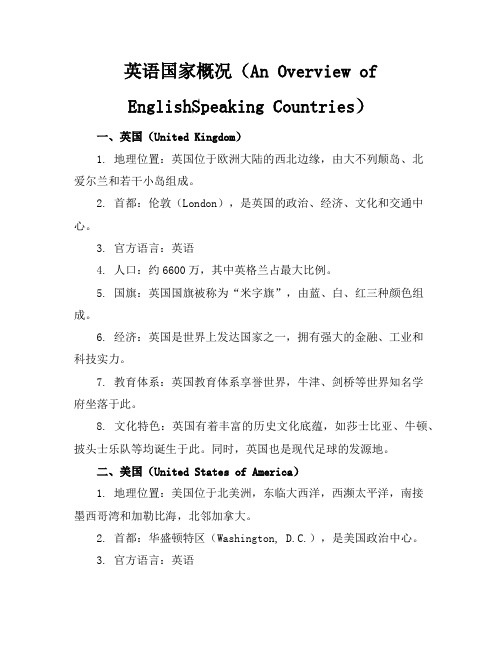
英语国家概况(An Overview ofEnglishSpeaking Countries)一、英国(United Kingdom)1. 地理位置:英国位于欧洲大陆的西北边缘,由大不列颠岛、北爱尔兰和若干小岛组成。
2. 首都:伦敦(London),是英国的政治、经济、文化和交通中心。
3. 官方语言:英语4. 人口:约6600万,其中英格兰占最大比例。
5. 国旗:英国国旗被称为“米字旗”,由蓝、白、红三种颜色组成。
6. 经济:英国是世界上发达国家之一,拥有强大的金融、工业和科技实力。
7. 教育体系:英国教育体系享誉世界,牛津、剑桥等世界知名学府坐落于此。
8. 文化特色:英国有着丰富的历史文化底蕴,如莎士比亚、牛顿、披头士乐队等均诞生于此。
同时,英国也是现代足球的发源地。
二、美国(United States of America)1. 地理位置:美国位于北美洲,东临大西洋,西濒太平洋,南接墨西哥湾和加勒比海,北邻加拿大。
2. 首都:华盛顿特区(Washington, D.C.),是美国政治中心。
3. 官方语言:英语4. 人口:约3.3亿,是世界上第三人口大国。
5. 国旗:美国国旗被称为“星条旗”,由红、白、蓝三种颜色组成。
6. 经济:美国是全球最大的经济体,拥有强大的科技创新能力和金融市场。
7. 教育体系:美国教育资源丰富,世界顶尖大学如哈佛、斯坦福等均位于此。
8. 文化特色:美国文化多元化,涵盖了欧洲、亚洲、非洲等多种文化元素。
好莱坞电影、NBA篮球、美式足球等在全球具有广泛影响力。
三、加拿大(Canada)1. 地理位置:加拿大位于北美洲北部,东临大西洋,西濒太平洋,北接北冰洋,南邻美国。
2. 首都:渥太华(Ottawa),是加拿大的政治中心。
3. 官方语言:英语和法语4. 人口:约3800万,是世界上面积第二大国家。
5. 国旗:加拿大国旗被称为“枫叶旗”,由红、白两色组成。
6. 经济:加拿大经济发达,资源丰富,特别是石油、天然气和矿产资源。
英语国家概况期末考试英国教育体制作文
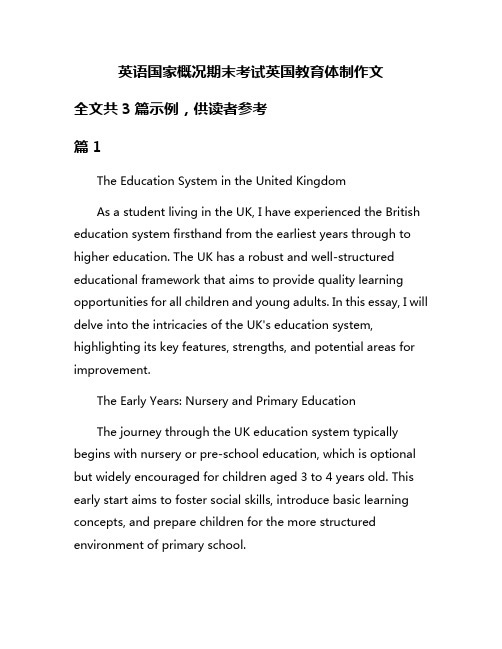
英语国家概况期末考试英国教育体制作文全文共3篇示例,供读者参考篇1The Education System in the United KingdomAs a student living in the UK, I have experienced the British education system firsthand from the earliest years through to higher education. The UK has a robust and well-structured educational framework that aims to provide quality learning opportunities for all children and young adults. In this essay, I will delve into the intricacies of the UK's education system, highlighting its key features, strengths, and potential areas for improvement.The Early Years: Nursery and Primary EducationThe journey through the UK education system typically begins with nursery or pre-school education, which is optional but widely encouraged for children aged 3 to 4 years old. This early start aims to foster social skills, introduce basic learning concepts, and prepare children for the more structured environment of primary school.Primary education in the UK is compulsory for children aged 5 to 11 and is divided into two stages: Key Stage 1 (ages 5-7) and Key Stage 2 (ages 7-11). During these formative years, students are introduced to core subjects such as English, Mathematics, Science, History, Geography, and Art. The curriculum is designed to develop fundamental skills in literacy, numeracy, and critical thinking.One strength of the primary education system in the UK is the emphasis on personalized learning and support. Teachers strive to identify individual student needs and adapt their teaching methods accordingly. Additionally, regular assessments and standardized tests, such as the Key Stage 1 and Key Stage 2 SATs (Standard Assessment Tests), help track student progress and identify areas for improvement.Secondary Education: A Diverse LandscapeUpon completing primary education, students transition to secondary school, typically between the ages of 11 and 16. The secondary education system in the UK is divided into Key Stage 3 (ages 11-14) and Key Stage 4 (ages 14-16).During Key Stage 3, students continue to study a broad range of subjects, including the core subjects of English, Mathematics, and Science, as well as additional subjects likeModern Foreign Languages, History, Geography, Art, Music, and Physical Education. This comprehensive curriculum aims to provide a well-rounded education and allow students to explore their interests and aptitudes.At the end of Key Stage 4, students take the General Certificate of Secondary Education (GCSE) examinations, which are nationally recognized qualifications that assess their performance in various subjects. The GCSE results play a crucial role in determining a student's future educational and career path.One notable aspect of the UK secondary education system is the diversity of school types available. Students can attend state-funded schools (such as community schools, academies, or faith schools), independent or private schools, or grammar schools (which have selective admission based on academic ability). This variety allows parents and students to choose an educational environment that aligns with their preferences and needs.Sixth Form and Vocational EducationAfter completing compulsory secondary education, students in the UK have several options for further study. One popular route is to continue their academic journey through sixth form orcollege, where they can pursue A-Levels (Advanced Level qualifications) or vocational qualifications.A-Levels are subject-based qualifications that are typically studied over two years. Students choose three or four subjects to focus on, which allows them to specialize in areas of interest and prepare for university admission. Common A-Level subjects include Mathematics, English Literature, Biology, Chemistry, Physics, History, Geography, and Modern Foreign Languages.Alternatively, students can opt for vocational qualifications, such as BTECs (Business and Technology Education Council) or NVQs (National Vocational Qualifications). These qualifications are designed to provide practical, work-related skills and knowledge, preparing students for specific careers or further vocational training.Higher Education: Universities and BeyondThe UK is renowned for its prestigious higher education institutions, including world-class universities such as Oxford, Cambridge, Imperial College London, and the University of Edinburgh, among many others. These institutions offer a wide range of undergraduate and postgraduate degree programs, attracting students from across the globe.To gain admission to a UK university, students typically need to meet specific entry requirements, which often include achieving certain grades in their A-Levels or equivalent qualifications. The application process is facilitated through the Universities and Colleges Admissions Service (UCAS), which serves as a centralized system for managing university applications.One strength of the UK higher education system is the emphasis on research and academic excellence. Many universities are at the forefront of cutting-edge research in various fields, providing students with opportunities to engage in groundbreaking work and contribute to advancing knowledge.Potential Areas for ImprovementWhile the UK education system has many strengths, there are also areas that could benefit from further improvement. One concern is the potential for socioeconomic disparities to impact educational outcomes. Students from disadvantaged backgrounds may face additional challenges in accessing quality education or receiving the necessary support and resources.Another area for consideration is the increasing emphasis on standardized testing and assessment, which can lead to anarrowing of the curriculum and excessive pressure on students and teachers. It is essential to strike a balance between accountability and fostering a love for learning and personal growth.Additionally, there are ongoing discussions around the need for greater investment in educational resources, teacher training, and support services to ensure that all students have access to high-quality learning experiences, regardless of their backgrounds or individual circumstances.ConclusionIn conclusion, the education system in the United Kingdom is a multifaceted and evolving framework that aims to provide quality education to all students. From the early years of nursery and primary school through to secondary and higher education, the UK offers a diverse range of educational pathways and opportunities.While the system has its strengths, such as personalized learning, academic rigor, and a focus on research excellence, there is also room for continuous improvement. Addressing socioeconomic disparities, finding the right balance between assessment and nurturing a love for learning, and investing ineducational resources are crucial areas that require ongoing attention and effort.As a student in the UK, I am grateful for the educational opportunities available to me and the dedication of educators who strive to foster a love for learning and personal growth. The UK education system, with its rich history and commitment to excellence, continues to shape the minds of future generations, equipping them with the knowledge, skills, and values necessary to thrive in an ever-changing world.篇2The Education System in the United KingdomAs a student in the UK, I have experienced the British education system firsthand from the early years through to higher education. The UK has a structured yet flexible approach to education that aims to provide quality learning opportunities for all children and young adults. In this essay, I will discuss the key stages, qualifications, and unique aspects of the UK's education system.Early Years and Primary EducationIn the UK, children typically start their educational journey in nursery or pre-school around the age of 3 or 4. This early yearseducation focuses on play-based learning, social development, and introducing basic literacy and numeracy skills. At the age of 5, children enter primary school, which lasts for 6 years until they are 11 years old.Primary education in the UK covers key subjects like English, mathematics, science, history, geography, art, music, and physical education. The curriculum is designed to develop a solid foundation in core academic areas while also nurturing creativity, critical thinking, and well-rounded personal growth. Primary schools use various teaching methods, including whole-class lessons, group work, and individual activities, to cater to different learning styles.Secondary Education and QualificationsAfter completing primary school, students move on to secondary education, which typically spans from ages 11 to 16 (or 18 in some cases). Secondary schools in the UK are divided into several key stages:Key Stage 3 (ages 11-14): This stage builds upon the knowledge and skills acquired in primary school, with a focus on subjects like English, mathematics, science, history, geography, foreign languages, art, music, and physical education.Key Stage 4 (ages 14-16): During these two years, students work towards obtaining their first major qualifications, typically the General Certificate of Secondary Education (GCSE) or equivalent qualifications. GCSEs are subject-based exams that assess a student's knowledge and skills in various subjects. They are graded from 9 (highest) to 1 (lowest), with a pass grade typically being 4 or above.After completing Key Stage 4, students have a choice to make:Continue in academic education and pursue A-Levels (Advanced Level qualifications) or other vocational qualifications like the BTEC (Business and Technology Education Council) at a sixth form college or a school with a sixth form.Seek employment or enroll in vocational training programs, such as apprenticeships or further education colleges.A-Levels and Vocational QualificationsFor those who choose to continue their academic education, A-Levels are the most common pathway. A-Levels aresubject-based qualifications that students typically study for two years (ages 16-18). Most students take three or four A-Level subjects, which are assessed through a combination ofcoursework and final exams. A-Levels are graded from A* (highest) to E, with A*, A, B, and C being considered passing grades for university entry.Alongside A-Levels, vocational qualifications like BTECs are also available. BTECs are more practical and work-related qualifications that prepare students for specific careers or higher education in a particular field. These qualifications are offered at various levels, from entry-level to higher national diplomas, and cover subjects like business, engineering, IT, art and design, and health and social care.Higher EducationAfter completing A-Levels or vocational qualifications, students can choose to pursue higher education at universities or other institutions. The UK has a diverse range of universities, including renowned institutions like Oxford, Cambridge, Imperial College London, and the University of Edinburgh, among many others.To gain admission to a university, students typically apply through the Universities and Colleges Admissions Service (UCAS). Entry requirements vary depending on the university and course, but generally, students need to meet specific grade requirements in their A-Levels or equivalent qualifications.Higher education in the UK offers a range of undergraduate and postgraduate degree programs, including bachelor's degrees (typically 3 years), master's degrees (1-2 years), and doctoral degrees (PhD, usually 3-4 years). Additionally, some universities offer foundation degrees, which are vocational qualifications that combine academic study with workplace learning.Unique Aspects of the UK Education SystemThe UK education system has several unique aspects that set it apart from other countries:Independent Schools (Private Schools): Alongsidestate-funded schools, the UK has a significant number of independent or private schools. These schools are fee-paying and often have a long tradition and reputation for academic excellence. Some of the most prestigious independent schools in the UK are known as "public schools," a term that can be confusing to those unfamiliar with the system.Grammar Schools: In certain areas of the UK, there are selective state-funded grammar schools that admit students based on their performance in an entrance examination. These schools are known for their academic rigor and often serve as apathway for high-achieving students to gain admission to top universities.Boarding Schools: The UK has a tradition of boarding schools, where students live and study on campus during term time. Boarding schools can be found in both the state and independent sectors and offer a unique educational experience with a focus on extracurricular activities and community living.Scottish Education System: Scotland has a slightly different education system from the rest of the UK, with its own qualifications (e.g., Nationals, Highers, and Advanced Highers) and a distinct curriculum. However, Scottish qualifications are recognized and accepted throughout the UK for university entry.In conclusion, the UK education system provides a comprehensive and structured approach to learning, with a focus on developing well-rounded individuals and preparing them for further academic pursuits or the workforce. From the early years through to higher education, the system offers a range of qualifications, pathways, and unique educational experiences that cater to the diverse needs and aspirations of students.篇3The Education System in the United KingdomAs a student in the UK, I have experienced the unique education system here firsthand. The UK has a long and storied history when it comes to education, with some of the oldest and most prestigious universities in the world located within its borders. However, the education journey begins much earlier than university for British students.Compulsory education in the UK starts at age 5 and continues until age 16. From ages 5-11, children attend primary school. The primary curriculum covers core subjects like English, math, science, history, geography, art, music, and physical education. At age 11, students move on to secondary school.Secondary Education (Ages 11-16)This is where the UK system starts to diverge from that of other countries. Instead of a single standardized curriculum, there are several "tracks" students can follow in secondary school. The two main options are:The General Certificate of Secondary Education (GCSE) routeVocational courses and apprenticeshipsThe GCSE is the most common path. Students work towards GCSE exams in a range of subjects like English, maths, sciences, humanities, languages, and electives. GCSE scores are crucial, asthey impact which advanced courses and universities students can progress to after age 16.Alternatively, some students opt for more vocational, hands-on training through courses like BTECs (Business and Technology Education Council qualifications). These allow students to develop practical skills in fields like construction, hospitality, or hair and beauty. Apprenticeships that combine work and study are another vocational option.Post-16 EducationOnce students turn 16, compulsory education ends. However, the majority stay in education until 18 to pursue one of three routes:A-LevelsVocational coursesWorkplace apprenticeshipsA-Levels (Advanced Levels) are two-year subject-based courses that prepare students for university. Students typically take 3-4 A-Level subjects of their choice in areas like maths, English, sciences, languages, humanities and arts. A-Level exams are extremely challenging, requiring deep subject mastery.Alternatively, students can take more vocational courses like BTECs at Level 3 (equivalent to A-Levels). Or they can begin higher-level apprenticeships, earning while receiving on-the-job training.Higher EducationAfter completing A-Levels or equivalent qualifications, students can apply to universities. The UK has a centralized university application system called UCAS that all students use.When applying, students must meet challenging entry requirements set by each university and degree program. These are largely based on A-Level grades and sometimes include admission tests.If accepted, students have two main options:Three-year bachelor's degreesFour-year degrees with an integrated master'sTuition fees for domestic UK/EU students are currently capped at £9,250 per year at public universities in England. Costs can be much higher for international students and at private institutions.Universities in the UK are globally renowned, with institutions like Oxford, Cambridge, Imperial, UCL, and many others ranking among the world's best. However, gaining entry to the top programs is enormously competitive.Overall ThoughtsAs a student, I appreciate how the UK system offers flexibility, with both academic and vocational pathways. The option to begin apprenticeships and career training straight out of secondary school provides alternatives to university for some students.That said, the system does involve extremely high-stakes testing like GCSEs and A-Levels. The pressure to perform well on these exams from an early age can be immense. University entry requirements and costs, especially for domestic students, are also very demanding compared to other European countries.Ultimately though, for academically-inclined students like me, the UK provides a world-class education from primary school through to higher education at its brilliant universities. The system has served me well so far in pursuing my potential through rigorous coursework and examinations.。
主要英语国家概况第4版
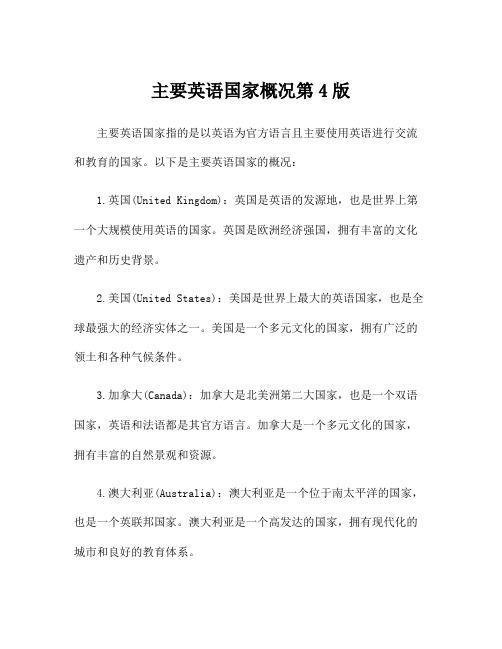
主要英语国家概况第4版
主要英语国家指的是以英语为官方语言且主要使用英语进行交流和教育的国家。
以下是主要英语国家的概况:
1.英国(United Kingdom):英国是英语的发源地,也是世界上第一个大规模使用英语的国家。
英国是欧洲经济强国,拥有丰富的文化遗产和历史背景。
2.美国(United States):美国是世界上最大的英语国家,也是全球最强大的经济实体之一。
美国是一个多元文化的国家,拥有广泛的领土和各种气候条件。
3.加拿大(Canada):加拿大是北美洲第二大国家,也是一个双语国家,英语和法语都是其官方语言。
加拿大是一个多元文化的国家,拥有丰富的自然景观和资源。
4.澳大利亚(Australia):澳大利亚是一个位于南太平洋的国家,也是一个英联邦国家。
澳大利亚是一个高发达的国家,拥有现代化的城市和良好的教育体系。
5.新西兰(New Zealand):新西兰是一个位于南太平洋的国家,也
是一个英联邦国家。
新西兰拥有优美的自然风光和多元文化的社会。
6.印度(India):印度是世界上人口第二多的国家,也是一个广泛
使用英语的国家。
英语在印度是官方语言之一,广泛用于政府、商务
和教育领域。
7.南非(South Africa):南非是非洲最发达的国家之一,也是一
个多元文化和多语言的国家。
英语是南非的官方语言之一,广泛用于
商务和教育领域。
以上是主要英语国家的概况,每个国家都有其独特的文化和特点,同时也是全球交流和教育的重要中心。
英语国家概况知识点总结
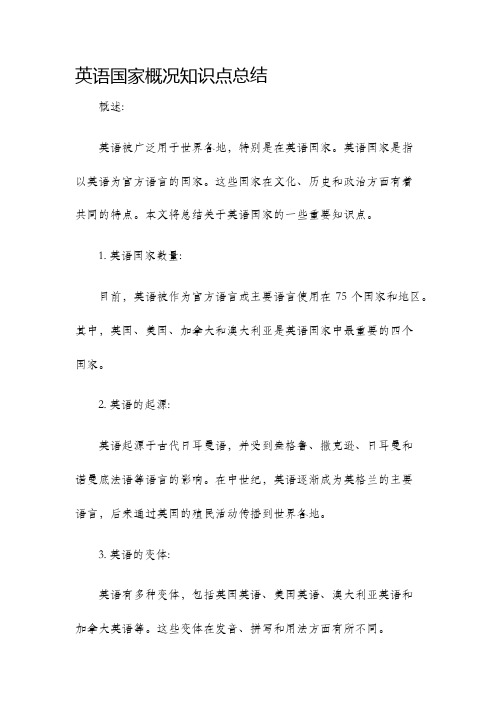
英语国家概况知识点总结概述:英语被广泛用于世界各地,特别是在英语国家。
英语国家是指以英语为官方语言的国家。
这些国家在文化、历史和政治方面有着共同的特点。
本文将总结关于英语国家的一些重要知识点。
1. 英语国家数量:目前,英语被作为官方语言或主要语言使用在75个国家和地区。
其中,英国、美国、加拿大和澳大利亚是英语国家中最重要的四个国家。
2. 英语的起源:英语起源于古代日耳曼语,并受到盎格鲁、撒克逊、日耳曼和诺曼底法语等语言的影响。
在中世纪,英语逐渐成为英格兰的主要语言,后来通过英国的殖民活动传播到世界各地。
3. 英语的变体:英语有多种变体,包括英国英语、美国英语、澳大利亚英语和加拿大英语等。
这些变体在发音、拼写和用法方面有所不同。
4. 英语国家的文化:英语国家的文化多样且富有活力。
英国是莎士比亚、达尔文和牛津剑桥等的故乡,以其丰富的文学、音乐和戏剧传统而闻名。
美国则以好莱坞电影、摇滚音乐和现代科技创新而著名。
澳大利亚和加拿大拥有美丽的自然风光,并注重多元文化的融合。
5. 英语国家的政治体制:英语国家有各种不同的政治体制。
英国是君主制国家,美国是联邦共和制国家,澳大利亚和加拿大则是联邦议会制国家。
这些国家在政治制度上有着明显的区别,但都保持着相对稳定的政治体系。
6. 英语的全球影响力:英语是联合国和其他国际组织的官方语言之一。
它也是全球商务和文化交流的主要语言。
掌握英语可以给人们提供更多的就业机会和交流平台。
7. 英语教育:英语是世界上最广泛学习的第二语言。
在许多英语国家,英语教育是义务教育的一部分。
英国、美国、加拿大和澳大利亚都有世界一流的教育体系,吸引着来自世界各地的留学生。
结论:英语国家在全球范围内有着重要的地位和影响力。
了解英语国家的概况能够帮助人们更好地理解英语语言及其文化背景。
掌握英语不仅是国际交流的必要工具,也是扩大人们视野和增加自身竞争力的关键。
英语国家概况之英国
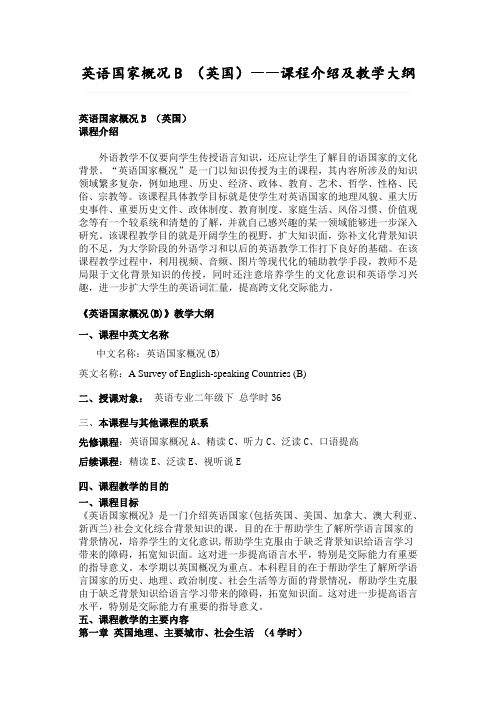
英语国家概况B (英国)——课程介绍及教学大纲英语国家概况B (英国)课程介绍外语教学不仅要向学生传授语言知识,还应让学生了解目的语国家的文化背景。
“英语国家概况”是一门以知识传授为主的课程,其内容所涉及的知识领域繁多复杂,例如地理、历史、经济、政体、教育、艺术、哲学、性格、民俗、宗教等。
该课程具体教学目标就是使学生对英语国家的地理风貌、重大历史事件、重要历史文件、政体制度、教育制度、家庭生活、风俗习惯、价值观念等有一个较系统和清楚的了解,并就自己感兴趣的某一领域能够进一步深入研究。
该课程教学目的就是开阔学生的视野,扩大知识面,弥补文化背景知识的不足,为大学阶段的外语学习和以后的英语教学工作打下良好的基础。
在该课程教学过程中,利用视频、音频、图片等现代化的辅助教学手段,教师不是局限于文化背景知识的传授,同时还注意培养学生的文化意识和英语学习兴趣,进一步扩大学生的英语词汇量,提高跨文化交际能力。
《英语国家概况(B)》教学大纲一、课程中英文名称中文名称:英语国家概况(B)英文名称:A Survey of English-speaking Countries (B)二、授课对象:英语专业二年级下总学时36三、本课程与其他课程的联系先修课程:英语国家概况A、精读C、听力C、泛读C、口语提高后续课程:精读E、泛读E、视听说E四、课程教学的目的一、课程目标《英语国家概况》是一门介绍英语国家(包括英国、美国、加拿大、澳大利亚、新西兰)社会文化综合背景知识的课。
目的在于帮助学生了解所学语言国家的背景情况,培养学生的文化意识,帮助学生克服由于缺乏背景知识给语言学习带来的障碍,拓宽知识面。
这对进一步提高语言水平,特别是交际能力有重要的指导意义。
本学期以英国概况为重点。
本科程目的在于帮助学生了解所学语言国家的历史、地理、政治制度、社会生活等方面的背景情况,帮助学生克服由于缺乏背景知识给语言学习带来的障碍,拓宽知识面。
英语国家概况教案Lesson
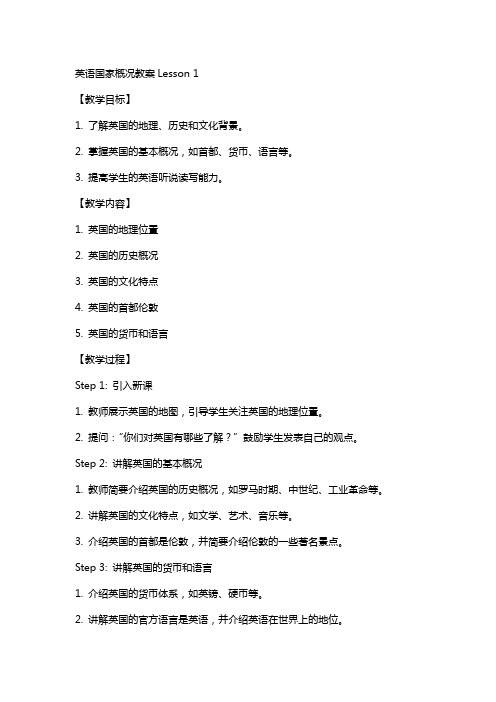
英语国家概况教案Lesson 1【教学目标】1. 了解英国的地理、历史和文化背景。
2. 掌握英国的基本概况,如首都、货币、语言等。
3. 提高学生的英语听说读写能力。
【教学内容】1. 英国的地理位置2. 英国的历史概况3. 英国的文化特点4. 英国的首都伦敦5. 英国的货币和语言【教学过程】Step 1: 引入新课1. 教师展示英国的地图,引导学生关注英国的地理位置。
2. 提问:“你们对英国有哪些了解?”鼓励学生发表自己的观点。
Step 2: 讲解英国的基本概况1. 教师简要介绍英国的历史概况,如罗马时期、中世纪、工业革命等。
2. 讲解英国的文化特点,如文学、艺术、音乐等。
3. 介绍英国的首都是伦敦,并简要介绍伦敦的一些著名景点。
Step 3: 讲解英国的货币和语言1. 介绍英国的货币体系,如英镑、硬币等。
2. 讲解英国的官方语言是英语,并介绍英语在世界上的地位。
Step 4: 互动环节1. 学生分组讨论,每组选择一个感兴趣的英国话题进行研究。
2. 各组汇报自己的研究成果,其他组成员提问。
2. 布置作业:请学生写一篇关于英国的小短文。
【教学评估】1. 观察学生在课堂上的参与程度,了解他们对英国概况的掌握情况。
2. 课后收集学生的作业,评估他们的写作能力。
英语国家概况教案Lesson 2【教学目标】1. 了解美国的地理、历史和文化背景。
2. 掌握美国的基本概况,如首都、货币、语言等。
3. 提高学生的英语听说读写能力。
【教学内容】1. 美国的地理位置2. 美国的歷史概况3. 美国的文华特点4. 美国的首都华盛顿特区5. 美国的货币和语言【教学过程】Step 1: 引入新课1. 教师展示美国的地图,引导学生关注美国的地理位置。
2. 提问:“你们对美国有哪些了解?”鼓励学生发表自己的观点。
Step 2: 讲解美国的基本概况1. 教师简要介绍美国的歷史概况,如发现新大陆、独立战争、南北战争等。
2. 讲解美国的文华特点,如电影、音乐、体育等。
英语国家概况V.-British-EducationPPT优秀课件
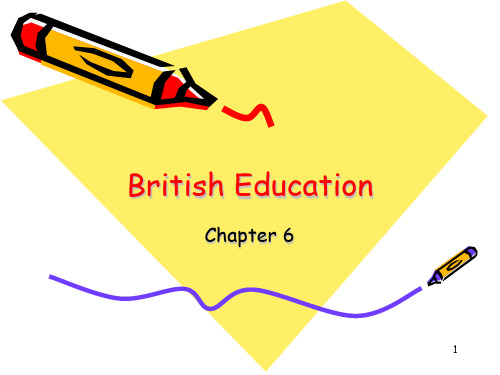
History of Education
• Now all children throughout the country must study the following subjects:
• English, mathematics, science, religious education, history, geography, technology, music, art, physical education, and a modern foreign language.
6
History of Education
• Through an exam called “the 11plus”, the government tried to raised the quality of education 1. Grammar Schools ----- where the most academically capable pupils were sent to be prepared for university. 2. Vocational Schools ----- where less successful pupils were sent to learn trades.
• an elite that "continues to dominate
Britain's political and cultural
establishment“ (occupies a high
proportion of the top level of many
aspects of British society---9% 0f the
2
- 1、下载文档前请自行甄别文档内容的完整性,平台不提供额外的编辑、内容补充、找答案等附加服务。
- 2、"仅部分预览"的文档,不可在线预览部分如存在完整性等问题,可反馈申请退款(可完整预览的文档不适用该条件!)。
- 3、如文档侵犯您的权益,请联系客服反馈,我们会尽快为您处理(人工客服工作时间:9:00-18:30)。
the Tripartite System
The Tripartite System /traɪ`pɑːtaɪt/ was the arrangement of state funded secondary education between 1944 and the 1970s in England and Wales, and from 1947 to 2009 in Northern Ireland. It was an administrative implementation of the Education Act 1944 and the Education Act (Northern Ireland) 1947. State funded secondary education was arranged into a structure containing three types of school, namely: grammar school, secondary technical school and secondary modern school. Pupils were allocated to their respective types of school according to their performance in the Eleven Plus examination. It was the prevalent system under the Conservative governments of the 1951 to 1964 period, but was actively discouraged by the Labour government after 1965. It was formally abolished in England and Wales in 1976 giving way to the Comprehensive System. However, elements of similar systems persist in several English counties such as Kent which maintains the grammar school system alongside comprehensive schools. The system's merits and demerits, in particular the need and selection for grammar schools, proved to be a contentious issue at the time and still remain so.
O Leveln schools
Designed for the majority of pupils----those who do not achieve scores in the top 25% of the eleven plus examination. Teachers are free to develop their own ideas, depending on the equipment and the qualifications.
British Education
Education is a vital concern throughout Britain because a highly developed nation depends upon educated professionals and a skilled workforce. The literacy rate in Britain is one of the highest in the world at over 99 percent.
Education System
Basic Education Higher Education
Elementary Secondary Education Education
Universities & Colleges
State Elementary Education
Public Elementary Education
/wiki/Tripartite_system_of_education_in_England,_Wales_and_Northern_Ireland
Eleven Plus examination
Usually, it consisted of three papers:
State schools
Independent schools
Comprehensive Schools Grammar Schools Secondary modern Schools Public schools
Grammar schools
The oldest schools in the UK (Shakespeare) Reserved for students who got high marks in the Eleven Plus examination or selected by other means Concerned with the business of getting ready for the examinations Some are academically among the best schools in England.
/wiki/Direct_grant_grammar_school
Direct grant grammar school
The status was introduced by the Education Act 1944 as a modification of an existing direct grant scheme to privately endowed schools. There were 179 direct grant grammar schools, which together with over 1200 grammar schools maintained by local authorities formed the most academic tier of the Tripartite System. They varied greatly in size and composition, but on average achieved higher academic results than either maintained grammar schools or independent schools. When state secondary education was reorganised on comprehensive lines in the 1970s, the direct grant was phased out and the schools required to choose between becoming maintained comprehensive schools or fully independent schools. Forty-five schools, almost all Roman Catholic, joined the state system, and a few closed. The rest (including all the secular schools) became independent, and mostly remain as highly selective independent schools.
Ages: 5-11
Kindergarten / Nursery Schools: 3-5
Ages: 3-13
Kindergarten / Nursery Schools: 3-5
Co-educational
Infants’ school/ First School: 5-7
Junior School: 7-11
Harrow School Winchester College
Eton College
Eton College is a private secondary school in Berkshire County in southern England. The preparatory school was founded by King Henry VI in 1440. A statue of Henry VI stands in the courtyard of the college.
Comprehensive secondary schools
A comprehensive school is a secondary school or state school for children from the age of 11 to at least 16 that does not select children on the basis of academic achievement or aptitude. Subjects learned Examinations before graduation
/wiki/Eleven_plus_exam
Most children took the Eleven Plus transfer test examination in their final year of primary school: usually at age 10 or 11.
Private School: 5Three terms with holidays 7/8 at Christmas, Easter, summer Pre School: 7/8-13
